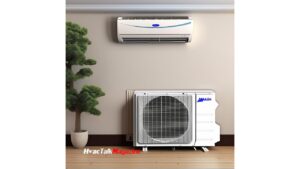Unlock Split AC vs Window AC Which is Best
As you stand in the sweltering heat, deliberating over which air conditioner to install in your home, you’re not alone. The eternal debate between split AC vs window AC which is best has left many of us perplexed. But fear not, dear reader! This guide is designed to demystify the differences between these two popular options, so you can make an informed decision that suits your unique needs. By the end of this article, you’ll be empowered to choose the perfect AC that will keep you cool, calm, and collected all summer long.
Split AC vs Window AC Which is Best: Key Takeaways:
- Space and Installation: Split ACs are more flexible in terms of installation and can be placed in any room, whereas Window ACs are limited to windows and require more space.
- Cooling Capacity: Split ACs have a higher cooling capacity than Window ACs, making them suitable for larger rooms or areas that require more cooling power.
- Energy Efficiency: Split ACs are generally more energy-efficient than Window ACs, which can lead to lower electricity bills and a reduced carbon footprint.
- Noise Level: Split ACs are typically quieter than Window ACs, which can be beneficial for bedrooms or living rooms where noise needs to be minimized.
- Aesthetics: Split ACs have a more modern and sleek design, which can enhance the appearance of a room, whereas Window ACs can be bulkier and less visually appealing.
- Maintenance: Split ACs require more complex maintenance compared to Window ACs, which can be a drawback for some users.
- Cost: Window ACs are generally more affordable upfront compared to Split ACs, but the latter can provide long-term savings through energy efficiency and longer lifespan.
Design and Installation
Before deciding between a split AC and a window AC, it’s vital to consider the design and installation aspects of each option. This will help you determine which one is best suited for your needs and space constraints.
Space Considerations for Split AC
An important factor to consider when opting for a split AC is the space required for the indoor unit. You’ll need to ensure that you have enough wall space to mount the unit, as well as sufficient clearance around it for proper airflow. Additionally, the outdoor unit will require a separate area, which can be a challenge if you live in a small apartment or have limited outdoor space.
Ease of Installation for Window AC
To install a window AC, you’ll need to remove the windowpane and secure the unit in place with brackets and screws. This process can be time-consuming and may require professional assistance, especially if you’re not comfortable with DIY projects.
With a window AC, you’ll also need to consider the weight of the unit and ensure that your window can support it. Furthermore, you’ll need to seal the gaps around the unit to prevent warm air from entering and cool air from escaping, which can be a challenge, especially if you have old or worn-out windows. However, once installed, a window AC can provide effective cooling and is often a more cost-effective option compared to a split AC.
Split AC vs Window AC Which is Best
Cooling Performance
It’s time to look into the heart of the matter – how well do these two types of air conditioners cool your space?
Cooling Capacity of Split AC
Cooling power is where split ACs truly shine. With a higher British Thermal Unit (BTU) rating, split ACs can effectively cool larger spaces, often with a single unit. This means you can enjoy a more consistent and comfortable temperature throughout your home or office.
Dehumidifying Capabilities of Window AC
Capacity to remove excess moisture from the air is a crucial aspect of an air conditioner’s performance. Window ACs tend to excel in this area, often removing more moisture from the air than split ACs. This can be particularly beneficial in humid climates or areas with poor ventilation.
Another significant advantage of window ACs is their ability to reduce humidity levels by up to 60%, making them ideal for areas prone to mold and mildew growth. However, it’s crucial to note that this increased dehumidifying capacity can sometimes lead to over-drying, which can be detrimental to your health and the overall air quality. Be sure to monitor the humidity levels and adjust the settings accordingly.
Split AC vs Window AC Which is Best: Energy Efficiency and Cost
To make an informed decision between split AC and window AC, it’s vital to consider their energy efficiency and cost implications. After all, you want to stay cool without breaking the bank or harming the environment.
Energy Star Ratings for Split AC
With Energy Star certification, split ACs have proven to be more energy-efficient than their window counterparts. Look for a rating of 4.5 or higher to ensure your split AC meets the energy efficiency standards set by the U.S. Environmental Protection Agency.
Operating Costs of Window AC
An important consideration when choosing between split AC and window AC is the operating cost. Window ACs are known to consume more power, which can lead to higher electricity bills.
It’s worth noting that window ACs often have lower upfront costs, but their higher energy consumption can add up over time. A window AC can increase your electricity bill by up to 30% compared to a split AC. This is because window ACs have to work harder to cool the air, which results in more energy being wasted. On the other hand, split ACs are designed to provide efficient cooling while minimizing energy consumption. By choosing a split AC, you can save up to 20% on your energy bills.
Split AC vs Window AC Which is Best: Maintenance and Durability
Once again, when it comes to maintenance and durability, both split AC and window AC have their own set of requirements and benefits. As you weigh your options, it’s necessary to consider the long-term implications of your choice.
Filter Cleaning for Split AC
Any split AC owner will tell you that regular filter cleaning is crucial to maintaining its performance and efficiency. You’ll need to clean or replace the filters every 1-2 months, depending on usage, to prevent dust and dirt buildup. This simple task can help reduce energy consumption by up to 15% and prolong the lifespan of your AC.
Coil Maintenance for Window AC
Cleaning the condenser coils on your window AC is vital to ensure optimal performance. You’ll need to remove any debris or dust that may have accumulated on the coils, as this can increase energy bills and reduce airflow.
Plus, neglecting coil maintenance can lead to more serious issues, such as refrigerant leaks or compressor failure, which can be costly to repair or even require replacement. By regularly cleaning the coils, you can prevent these problems and enjoy a cooler, more comfortable space.
Split AC vs Window AC Which is Best: Summing up
Ultimately, you’ve weighed the pros and cons of split ACs and window ACs, and now it’s time to make an informed decision about which one is best for your needs. Recall, your choice will impact your comfort, energy bills, and even the aesthetic of your space. By considering factors like installation, maintenance, and noise levels, you’ll be able to choose the perfect air conditioning solution that fits your lifestyle and preferences. So, take a deep breath, and unlock the cool, comfortable air you deserve.
Still need more information about choosing between split AC vs window AC which is best, unlock the best option for your home with our FAQ guide! Compare efficiency, installation, and cost to make an informed decision.
👉 Read more and find out which AC system is the perfect fit for your cooling needs! Don’t miss out—enhance your home comfort today!
Split AC vs Window AC Which is Best: FAQ
Q: What is the main difference between Split AC and Window AC?
A: The main difference between Split AC and Window AC is their design and installation. Split AC consists of two units – an indoor unit and an outdoor unit, connected by a refrigerant pipe, whereas Window AC is a single unit that is installed in a window. This difference affects their performance, noise level, and aesthetics.
Q: Which type of AC is more energy efficient, Split AC or Window AC?
A: Split AC is generally more energy efficient than Window AC. Since Split AC has an outdoor unit that can be placed in a shaded area, it reduces the load on the compressor, resulting in lower energy consumption. Additionally, Split AC often comes with inverter technology, which adjusts the compressor speed according to the cooling demand, further reducing energy consumption.
Q: Which AC type is better suited for larger rooms, Split AC or Window AC?
A: Split AC is better suited for larger rooms. Since Split AC has a separate indoor unit, it can be installed in a larger room and still provide effective cooling. Window AC, on the other hand, is designed for smaller rooms and may not be able to cool a larger room effectively.
Q: Is Split AC more expensive than Window AC?
A: Yes, Split AC is generally more expensive than Window AC. The cost of a Split AC system includes the cost of the indoor unit, outdoor unit, and installation, which can be higher than the cost of a Window AC. However, Split AC provides more benefits, such as energy efficiency, quieter operation, and better aesthetics, which can justify the additional cost.
Q: Which AC type is easier to install, Split AC or Window AC?
A: Window AC is generally easier to install than Split AC. Window AC can be installed by simply placing it in a window and plugging it in, whereas Split AC requires more complex installation, including connecting the indoor and outdoor units with a refrigerant pipe.
Q: Can Split AC be used for heating, whereas Window AC cannot?
A: Yes, many Split AC systems come with a reverse cycle feature, which allows them to be used for heating in winter. Window AC, on the other hand, is designed only for cooling and cannot be used for heating.
Q: Which AC type is more aesthetically pleasing, Split AC or Window AC?
A: Split AC is generally considered more aesthetically pleasing than Window AC. Since Split AC has a separate indoor unit, it can be installed discreetly on a wall, without obstructing the view from a window. Window AC, on the other hand, is installed in a window, which can affect the appearance of the room.
Learn more and join our mailing list for updates.
Follow Us on Google Chrome
To get started, switch to Google Chrome Browser
1. Already on our site
2. Top right, tap the 3 dots
3. Bottom right, tap follow
4. You are done.
This post has been written by Team HVAC Talk Magazine. Stay informed and connected with the latest in HVAC—join us for expert advice, troubleshooting tips, and news updates. Don’t miss out, follow us now! #HVACExperts #HVACTips #StayInformed #HVACProTalk!










